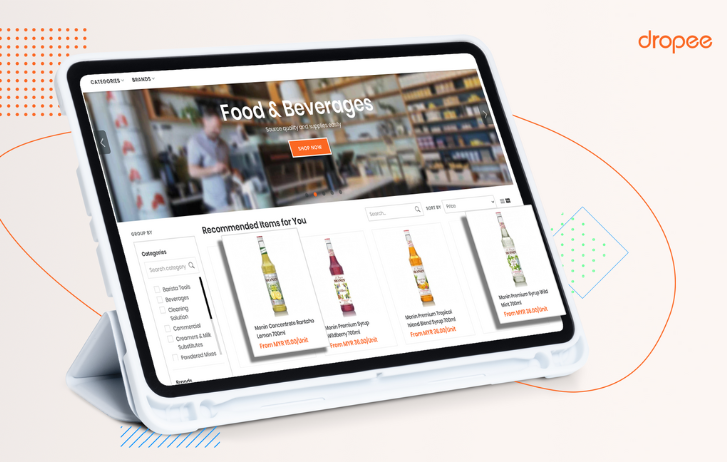
3 Reasons Automation Is A Gamechanger For B2B SMEs
By Lennise Ng | First published: January 19, 2023 Updated: February 29, 2024
As the B2B e-commerce market grows, so does competition. Enhanced digital tools such as automation and platform integration can help SMEs offer superior customer experiences and stand out from the crowd.
In today’s omni-online era, it’s so important to build business presence across both online and offline channels. Gone are the days when only a small fraction of the population was connected online. Southeast Asia is now a booming digital economy with over 400 million internet users.
This is reflected in how we live, work and shop. My experience in running a B2B wholesale marketplace in Malaysia – a market with an exceptionally high internet penetration rate of 93.8% - has given me a front-row seat in how technology is fueling online commerce and trade across Asia.
Asia leading the way for mobile-first society
In Asia, consumers are increasingly active online and mobile-first across all age groups. We’ve seen rising demand for B2B and wholesale trade on digital platforms - projected to grow at a rate of 12.1% per annum.
New and existing B2B e-commerce businesses are actively building omnichannel retail strategies. Demand for enhanced digital tools and platforms, talent support, and upskilling to keep up with a fast-moving marketplace, have never been higher.
Businesses, especially SMEs, need support with digitization. Many face difficulties finding and training teams to plan and execute their digital transformation. Others have challenges identifying the technology partners and solutions that can elevate their businesses and enhance customer experience and service offerings.
Improving the B2B buyer and seller experience, one customer at a time
All of these reasons led me and my co-founders to start Dropee back in 2017. We knew that the B2B buying and selling experience could be better.
Many companies were still using outdated systems for sales and inventory management, causing information to be siloed, disconnected and unreliable due to lack of transparency. This created barriers for SMEs looking to optimize and expand.
At Dropee, we created a one-stop B2B platform that integrates technology into the current supply-chain ecosystem. We aim to simplify the wholesale experience and connect manufacturers, distributors and retailers across the chain. That way, they can trade faster, smarter, and at a lower cost.
Read on for three reasons why I believe SMEs should adopt automation and platform integration for greater business success:
1. Enhance the customer experience
The evolution of tech and digitization has led to an increase in hyper-personalization and speed of customer experience in the B2C market. Great news for shoppers, but the same quality of service is also in demand for B2B.
What we’ve seen at Dropee, however, is that not every distributor, wholesaler, or brand has the right tools to provide personalized, speedy customer experience for B2B sales, from outreach and engagement to repeat orders. What businesses need is a B2B strategy that integrates across their online and offline sales channels to provide a seamless ordering experience.
Sales reps must oversee order status across multiple channels and sell smarter with more customized offerings tailored to purchase patterns and customer preferences.
For wholesale customers, a one-stop online ordering platform can save time spent browsing different product catalogs and comparing prices in multiple platforms or channels. According to our data, this increases re-order frequencies from preferred suppliers by up to 1.3x, building more loyalty and trust.
2. Simple and insightful inventory management
Inventory management is one of the biggest pain points for SMEs, and it only increases with the addition of new channels, locations, and stores. Smaller companies can also find it difficult to allocate extra manpower to manage inventory. For businesses to scale up, the first step is adopting the right platform to consolidate stock count across multiple channels.
Automating inventory allows deeper insights for businesses to identify hero products with higher sales volume and profit margins. As well as focusing more resources on bestsellers, automation can reduce obsolete product categories for greater overall profit.
Smart AI-powered automation technology can suggest which products to pair or group together for bigger sales volume for each customer. This allows better product targeting and trade marketing campaigns to focus attention on specific or fast-growing market segments.



3. Manage cash flow better for survival
Cash flow is one of the major factors that determine an SME’s life cycle. Effective credit management helps business owners maintain their financial health and reduce the risk of negative cash flow.
Steady cash flow means companies can settle payment with suppliers on time. They can also allocate budget for investing in research and development for new products, as well as service upgrades.
Traditionally, businesses would opt for standard financing options such as bank loans. However, a tougher economic climate has increased the risk of banks giving out loans to businesses, and drawing down on additional capital is restricted.
B2B platforms like Dropee offer credit terms of up to 60 days, so SMEs can tap automated credit financing services to expand and grow. Some e-commerce marketplaces are even offering credit terms at 0% interest fees for registered sellers.



The future of e-commerce is now
The B2B e-commerce market is constantly evolving. To stay competitive, businesses need strong positioning across all available channels to make the most of opportunities as they emerge. It’s vital for SMEs to adopt digital transformation and level up fast.
Digital solutions that automate and integrate supply-chain can do more than just simplifying operations. Automation also enables growth, thanks to the ability to tap actionable data-driven insights and access alternative finance streams.
To discover more insights and tips for SMEs across Asia, Middle East and Africa, head here.
SHARE THIS STORY
- How To Ship A Giant Panda
- How To Make Freight Shipments Work For Your Small Business
- The Rise Of Intra-Asia Trade: Opportunities In The China-Southeast Asia Corridor
- Southeast Asia: The Next Manufacturing Powerhouse?
- 8 Most Unusual Shipments In The History Of FedEx
- Where Do Old Planes Go When They Retire?
Sign up now and save on your shipping rates!
Sign up now and earn discounts by shipping instantly with FedEx Ship ManagerTM at fedex.com.
Recommended For You

6 Trends Shaping The Future Of E-Commerce
APAC e-tailers can take advantage of megatrends to drive growth and improve customer experience. Download our e-commerce white paper.
Read More
How E-Commerce Integration Has Transformed Online Retail
The rise of new, tech-driven e-commerce platforms has led to a new era of online retail. We’re now in the omnichannel age of e-commerce integration.
Read More
How To Surf The Digital Economy Successfully
More and more shoppers are surfing online stores through their mobile phones and social media.
Read More

